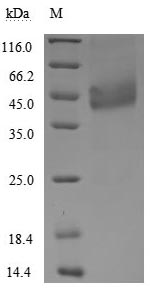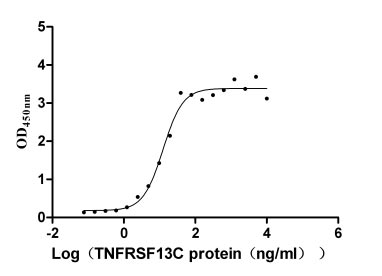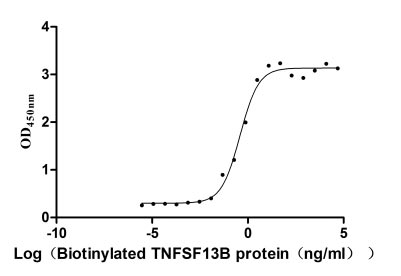The recombinant human TNFRSF13C protein is an active protein generated in mammalian cells. Its production is achieved by introducing a plasmid construct containing the gene fragment encoding the 7-71aa of the human TNFRSF13C into the mammalian cell expression system. This TNFRSF13C protein is tagged with a hFc-Flag at the C-terminus. SDS-PAGE analysis indicates its purity greater than 95%, while LAL testing confirms endotoxin levels below 1.0 EU/μg. The biological activity of the TNFRSF13C protein is validated via ELISA, showing specific binding toTNFSF13B (CSB-MP897523HU1) and biotinylated human TNFSF13B (CSB-MP897523HU1-B) with an EC50 of 9.943-15.72 ng/ml and 0.2699-0.5613 ng/ml, respectively.
Human TNFRSF13C (BAFF-R) is a vital receptor in the immune system that regulates B-cell survival and function through its interaction with BAFF. This receptor is primarily expressed on B cells, where it plays a pivotal role in their maturation and activation processes [1][2]. The interaction between BAFF and TNFRSF13C is crucial for maintaining the balance of B-cell populations, as dysregulation can lead to the survival of autoreactive B cells, contributing to autoimmune pathology [3][4].
Research has shown that variations in the TNFRSF13C gene can influence susceptibility to autoimmune diseases and other immune disorders. Specific genetic variants of TNFRSF13C have been associated with common variable immunodeficiency (CVID) and autoimmune lymphoproliferative syndrome-like conditions, highlighting its importance in immune regulation [1][5].
In the context of cancer, TNFRSF13C has been identified as a potential therapeutic target, particularly in B-cell malignancies. Its expression is often upregulated in various types of lymphomas, making it a promising candidate for targeted therapies aimed at modulating B-cell activity [2][6].
References:
[1] R. Russo, I. Andolfo, V. Lasorsa, S. Cantalupo, R. Marra, G. Frisso, et al. The tnfrsf13c h159y variant is associated with severe covid-19: a retrospective study of 500 patients from southern italy, Genes, vol. 12, no. 6, p. 881, 2021. https://doi.org/10.3390/genes12060881
[2] Z. Dong, J. Song, E. Thieme, A. Anderson, E. Oh, W. Cheng, et al. Generation of a humanized afucosylated baff-r antibody with broad activity against human b-cell malignancies, Blood Advances, vol. 7, no. 6, p. 918-932, 2023. https://doi.org/10.1182/bloodadvances.2022008560
[3] J. Frostegård, C. Hellström, P. Nilsson, A. Frostegård, & S. Ajeganova. Autoantibody profiling reveals four protein candidate autoantigens associated with systemic lupus erythematosus, Lupus, vol. 27, no. 10, p. 1670-1678, 2018. https://doi.org/10.1177/0961203318788153
[4] M. Morissette, Y. Gao, P. Shen, D. Thayaparan, J. Bérubé, P. Paré, et al. Role of baff in pulmonary autoantibody responses induced by chronic cigarette smoke exposure in mice, Physiological Reports, vol. 4, no. 24, 2016. https://doi.org/10.14814/phy2.13057
[5] A. Richard, J. Peters, J. Lee, G. Vahedi, A. Schäffer, R. Siegel, et al. Targeted genomic analysis reveals widespread autoimmune disease association with regulatory variants in the tnf superfamily cytokine signalling network, Genome Medicine, vol. 8, no. 1, 2016. https://doi.org/10.1186/s13073-016-0329-5
[6] G. Fazio, N. Turazzi, V. Cazzaniga, M. Kreuzaler, O. Maglia, C. Magnani, et al. tnfrsf13c (baffr) positive blasts persist after early treatment and at relapse in childhood b‐cell precursor acute lymphoblastic leukaemia, British Journal of Haematology, vol. 182, no. 3, p. 434-436, 2017. https://doi.org/10.1111/bjh.14794









